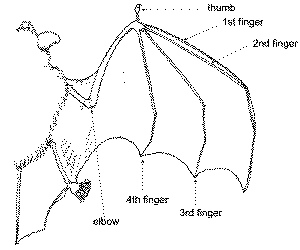The Wing
Bats are the only mammal that can sustain flight. This peculiarity sets them apart from all other mammals on earth, but is a costly adaptation, requiring specialized anatomical changes from other mammals. Some basics are not that much different however. The wing skeleton is not much different from that of the forelimb of most normal mammals. The upper arm bone (humerus) is essentially the same as in all mammals. The muscles that bind and move the bone are essentially the same as in man, except longer, and proportionally larger. The forearm illustrates the first in a series of specialized modifications. In typical mammals, the forearm is made up of two bones - the radius and the ulna. In bats the ulna is greatly reduced in size and appears as a thin thread-like bone fused to the much larger and elongated radius. The wrist region is essentially the same as most mammals, however it is less flexible as the ulna is greatly reduced, and the radius has lost it’s rotational ability. The hand is basically the same as in humans, except for the elongation of the fingers (phalanges). The thumb is directed more forward than in humans and has a strong claw at the end of it. In the family Furipteridae, the claw is minute and apparently functionless. Many other fruit bats have a claw on the second finger protruding beyond the wing membrane. The length of the thumb is variable. It is quite long and flexible in Old World Fruit bats where it is used for everything from food gathering to fighting. In many of the Microchiroptera, the thumb is quite small. The remaining fingers vary in length and number of bones from family to family. This diversity creates wings of different shapes and sizes, presumably providing various flight characteristics for the various types of hunting strategies.
Stretched between the various digits, is a membrane of skin. A special muscle extending form the shoulder to the base of the thumb, when contracted, causes a general down-turning and thus an increase in the surface area of this portion of the wing. This helps to change the aerodynamic curvature (or camber) of the wing. As a general rule, the membrane connects to the side of the body, hindlimb and the foot. The wing area may be supplemented by the addition of a membrane stretched between the hindlimbs and the tail (called interfemoral membrane), and sometimes along the calcar. Most flying fox bats do not have an external tail and so this area is often absent of membrane.

These membranes often appear delicate, they are actually quite tough and resilient in order to resist being torn by things like thorns and twigs. While rubber surgical gloves are thicker and more elastic than wing membranes, they are more prone to puncture than bat wings! Plastic sandwich bags are about the same in thickness, and only slightly more elastic, but have about the same puncture strength as a bat wing. These wings are highly vascular, and they appear to heal quickly in most cases, although I have seen small tears take three years to begin healing, while holes only slightly smaller on the same bat, but the opposite wing, have healed in only a few weeks! Wings are generally naked, however some species have more hair than others (Lasiurus), possibly for the purpose of catching insects. Usually black or greyish brown in colour, some African vespertilionids have wing membranes that are white or greyish white. White wing-tips are commonly found among members of the New World leaf-nosed bats. Yellow and white spots are found on the wings of Tube-nosed fruit bats in the Indo-Australian region. The Black-bellied fruit bat from Papua has rich reddish-orange wings.
Wings are sometimes used for more than flying. High speed photography has shown some bats using their wings to catch insects, by hitting the insect much like one would use a tennis racket to hit a ball. By striking the insect, and deflecting it toward the uropatagium, they will literally tuck their heads down and perform a somersault in the air as they retrieve the insect from the pocket created by their tail and uropatagium!
Wings are highly vascular for a number of reasons. They require nutrients and oxygen to be transported to the muscles, as well as radiating excess heat. Additionally, gas exchange is accommodated through the vascular network of the wing. During flight large amounts of carbon dioxide is created by the flight muscles. Most mammals exchange this gas through the lungs, and while bats also do this, a certain amount is also exchanged through the wing membranes. Studies have shown that Big brown bats exchange as much as 11.5 per cent of carbon dioxide through the wing membranes. The wings do NOT however serve a true respiratory function, in that they do NOT take in oxygen.
